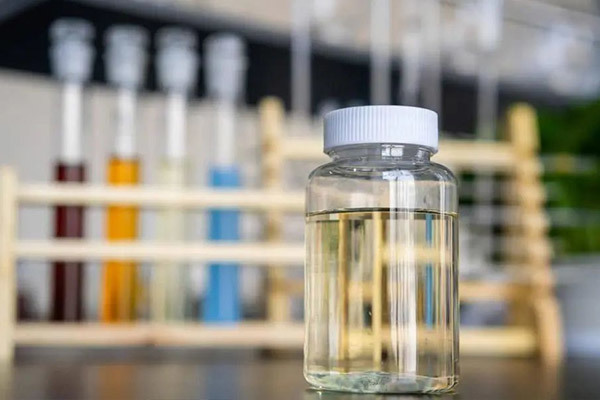Gluconolactone
Release time:
2024-08-23
Sodium gluconate, also known as sodium pentahydroxycaproate, has good thermal stability and is non-hygroscopic. It is widely used in industries such as food, construction, water treatment, and electroplating.
Sodium gluconate, also known as sodium pentahydroxyhexanoate, has good thermal stability and is non-hygroscopic. It is widely used in industries such as food, construction, water treatment, and electroplating. Currently, the main production methods for sodium gluconate include microbial fermentation, electrolysis, catalytic oxidation, and dual-enzyme methods. Its molecular formula is C6H11NaO7, with a relative molecular mass of 218.14, a melting point of 206-209°C, and it appears as white or yellow crystalline granules or powder. The pH (10% aqueous solution) ranges from 6.2 to 7.8; it is highly soluble in water, slightly soluble in ethanol, insoluble in ether, has a salty taste, good thermal stability, and is non-hygroscopic.
Sodium gluconate is a widely used polyhydroxy organic acid salt with extensive applications in the food, light industry, and chemical industries.
Industrial aspects
Sodium gluconate has very broad applications in industry; it can be used as an efficient chelating agent in construction, textile dyeing, metal surface treatment and water treatment industries; as a steel surface cleaning agent; as a glass cleaning agent; and as an efficient retarder in the concrete industry.

(1) Corrosion inhibition and scale prevention performance: Sodium gluconate serves as a water quality stabilizer. It is a polyhydroxy carboxylic acid type buffering scale inhibitor with excellent corrosion inhibition and scale prevention properties. It can be used together with various corrosion inhibitors such as sodium benzoate and polyaspartic acid to enhance corrosion inhibition performance. Compared to other corrosion inhibitors, sodium gluconate has good characteristics: (i) it exhibits significant coordination effects suitable for various formulations involving molybdenum, silicon, phosphorus, tungsten, nitrites etc., greatly improving the corrosion inhibition effect due to coordination effects; (ii) unlike general corrosion inhibitors where the corrosion rate decreases with increasing temperature; (iii) sodium gluconate has strong complexing ability towards calcium, magnesium and iron salts especially showing excellent chelation with Fe2+; (iv) As a circulating cooling water corrosion inhibitor/scaling agent it surpasses other currently used inhibitors achieving pollution elimination.
(2) Chelation performance: Sodium gluconate is widely used as a cleaning agent due to its excellent chelation properties across various industrial sectors including water treatment, electroplating and surface cleaning of metals/non-metals along with cement production. Sodium gluconate: (i) serves as a specialized cleaning agent for glass bottles in the food and beverage industry where formulations based on sodium gluconate improve decontamination efficiency while meeting green safety environmental requirements; (ii) acts as a steel surface cleaning agent in platinum plating or chrome plating industries where strict cleaning of steel surfaces before plating processes like platinum or chrome coating ensures firm bonding between coatings and steel surfaces—adding sodium gluconate to cleaning agents achieves ideal results.

(3) The performance of sodium gluconate in concrete mainly includes its role as a retarder and water-reducing agent. As a water-reducing agent it enhances workability acting like a plasticizer while reducing cement content. As a retarder sodium gluconate exhibits superior characteristics by significantly delaying the initial hydration process of cement extending setting time for cement paste/concrete improving fluidity [1]; influencing strength development after hardening [2]; prolonging setting properties of cohesive sand-gravel enhancing compressive strength.

Food aspects
As an important food additive sodium gluconate has wide applications in nutritional supplements food preservatives quality improvers and buffering agents. Sodium gluconate improves flavor masking off-flavors regulates pH replaces salt etc., showing great potential for use in pickled foods dairy products among others.
(1) Application of sodium gluconate in salted foods: The "2022-2028 Global & China Sodium Gluconate Market Monitoring Research & Investment Potential Assessment Forecast Report" mentions that the salty taste quality of sodium gluconate closely resembles that of table salt while its sodium molecular weight accounts for only 10.5%, making its sodium content only one-fourth that of table salt when compared to other low-sodium salts which have advantages such as being non-irritating having no bitter taste or salty flavor making it an optimal substitute for table salt. It is currently widely applied in salt-free soy sauce bread etc., also replacing table salt during food processing improving characteristics adjusting fermentation providing preservation dehydration functions etc. Research by Japan's Central Miso Research Institute indicates that using sodium gluconate instead of table salt during miso fermentation allows normal fermentation while achieving reduced-salt or salt-free miso production. Hiroyuki T et al.[5] utilized sodium gluconate to partially replace table salt producing low-sodium bread which reduced fermentation time for sweetened bread types without causing differences in volume or affecting overall flavor shelf life when completely replacing NaCl with sodium gluconate.
(2) Flavor improvement property: Sodium gluconate can enhance food flavors by masking bitterness off-flavors improving taste significantly impacting overall flavor enhancement effectiveness notably when added at around 5% concentration into sausages effectively reducing soybean protein odor according to Zhou Xiuqin et al.[6].
(3) Nutritional enhancement property: As multifunctional food additive not only does sodium gluconate improve flavors but also enhances nutritional characteristics within foods such that L E Metzgert et al.[7] through detailed studies on cheese hardening phenomena found that it forms soluble complexes with calcium ions lactic acid ions within cheese thereby increasing calcium lactates solubility effectively preventing cheese hardening while ensuring nutritional quality.

(4) pH regulation property: The buffering range pH for glucuronic acid lies between pH3-4 making it suitable for use within low pH range buffering agents among food additives. Sodium glucuronates application within beverage industry not only reduces sterilization conditions but also maintains excellent taste.
Related News
Through this training, the management team has improved individual professional skills, enhanced teamwork abilities, and stimulated innovative awareness, all of which will become a valuable asset for the entire sales team in future work!
2024-10-27
On June 28, the fourth batch of students successfully completed their course, which also marks the successful conclusion of the journey of "Shandong Fuyang Biotechnology Co., Ltd. Biological Manufacturing Professional Skills Learning Enhancement."
2024-06-28
Erythritol has a wide range of applications in the food industry, serving as a sweetener for diabetics and consumers who prefer not to consume sugar. It is used in the processing of chocolate, chewing gum, cream candies, muffins, and more.
2024-10-10
We use technology to change corn and create a better life with corn.
Corn starch, also known as maize starch or corn flour, is commonly referred to as six-grain flour. It is a white powder with a slight yellow tint. It is made by soaking corn and then processing it through crushing, sieving, sedimentation, drying, and grinding. Ordinary products contain small amounts of fat and protein, and have strong hygroscopicity.
2024-09-27
Allulose | Good product, made by Fuyang
Allulose is a type of rare sugar that exists in small amounts in nature. It is classified as a hexose and a ketose, corresponding to the C-3 position of D-fructose as its epimer.
2024-09-25
Use trehalose to achieve good color and flavor.
I believe that making delicious and beautiful flower jam and flower cakes is a joy for many friends. Today, I will guide you to make flower jam and flower cakes with added trehalose. Come on! Let's go!
2024-09-21


